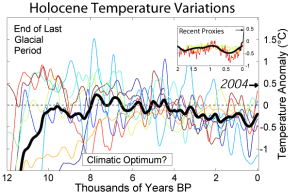-
Note: "ka"
means "thousand years" (non-calibrated C14 dates)
Paleontologists have defined no
faunal stages for the Holocene. If subdivision is necessary, periods of
human technological development, such as the
Mesolithic,
Neolithic,
and
Bronze Age, are usually used. However, the time periods referenced by
these terms vary with the emergence of those technologies in different parts
of the world.
Climatically, the Holocene may be divided evenly into the
Hypsithermal and
Neoglacial periods; the boundary coincides with the start of the
Bronze
Age in European civilization. According to some scholars, a third
division, the
Anthropocene, began in
the 18th century.
The Holocene is expected to end within a few thousand years.
Geology
Continental motions are less than a kilometre over a span of only 10,000
years. However, ice melt caused world
sea levels to rise about 35 m (110 ft) in the early part of the
Holocene. In addition, many areas above about
40 degrees north latitude had been depressed by the weight of the
Pleistocene glaciers and rose as much as 180 m (600 ft) over the late
Pleistocene and Holocene, and are still rising today.
The sea level rise and temporary land depression allowed temporary marine
incursions into areas that are now far from the sea. Holocene marine fossils
are known from
Vermont,
Quebec,
Ontario,
and Michigan. Other than higher latitude temporary marine incursions
associated with glacial depression, Holocene fossils are found primarily in
lakebed, floodplain, and cave deposits. Holocene marine deposits along
low-latitude coastlines are rare because the rise in sea levels during the
period exceeds any likely upthrusting of non-glacial origin.
Post-glacial rebound in the
Scandinavia region resulted in the formation of the
Baltic
Sea. The region continues to rise, still causing weak
earthquakes across
Northern Europe. The equivalent event in
North America was the rebound of
Hudson
Bay, as it shrank from its larger, immediate post-glacial
Tyrrell Sea phase, to near its present boundaries.
Climate
Climate has been fairly stable over the Holocene.
Ice core
records show that before the Holocene there was global warming after the end
of the
last ice age and cooling periods, but climate changes became more
regional at the start of the
Younger Dryas. During the transition from last glacial to holocene, the
Huelmo/Mascardi Cold Reversal in the Southern Hemisphere began before
the Younger Dryas, and the maximum warmth flowed south to north from 11,000
to 7,000 years ago. It appears that this was influenced by the residual
glacial ice remaining in the Northern Hemisphere until the later date.
The
hypsithermal was a period of warming in which the global climate became
warmer.
However, the warming was probably not uniform across the world. This
period ended about 5,500 years ago, when the earliest human civilizations in Asia and
Africa were
flourishing. This period of warmth ended with the descent into the
Neoglacial. At that time, the climate was not unlike today's, but there
was a slightly warmer period from the
10th–14th
centuries known as the
Medieval Warm Period. This was followed by the
Little Ice Age, from the
13th or 14th century to the mid
19th century, which was a period of significant cooling, though not
everywhere as severe as previous times during neoglaciation.
The Holocene warming is an interglacial period and there is no reason to
believe that it represents a permanent end to the
current ice age. However, the current
global warming may result in the Earth becoming warmer than the
Eemian Stage, which peaked at roughly 125,000 years ago and was warmer
than the Holocene. This prediction is sometimes referred to as a
super-interglacial.
Compared to glacial conditions, habitable zones have expanded northwards,
reaching their northernmost point during the hypsithermal. Greater moisture
in the polar regions has caused the disappearance of
steppe-tundra.
Ecological Developments
Animal and plant life have not evolved much during the relatively short
Holocene, but there have been major shifts in the distributions of plants
and animals. A number of large animals including
mammoths
and
mastodons,
saber-toothed cats like
Smilodon
and
Homotherium, and
giant sloths disappeared in the late Pleistocene and early
Holocene—especially in North America, where animals that survived elsewhere
(including horses and camels) became extinct. This extinction of American
megafauna
has been explained as caused by the arrival of the ancestors of
Amerindians; though most scholars assert that climatic change also
contributed, as well as a cometary
bolide event over North America which is theorized to have triggered the
Younger Dryas.
Throughout the world, ecosystems in cooler climates that were previously
regional have been isolated in higher altitude ecological "islands."
The
8.2 ka event, an abrupt cold spell recorded as a negative excursion
in the
δ18O
record lasting 400 years, is the most prominent climatic event occurring in
the Holocene epoch, and may have marked a resurgence of ice cover. It is
thought that this event was caused by the final drainage of
Lake Agassiz, which had been confined by the glaciers, disrupting the
thermohaline circulation of the
Atlantic.
Impact Events
Many
meteorite
events which occurred
in the Holocene have
been discovered in Europe, as well as in seas such as the
Indian Ocean and near remote
Siberia (Tunguska
event).
End of Reading

Return to the
Old Earth Ministries Online Earth
History Curriculum homepage.
Source:
Holocene Epoch
